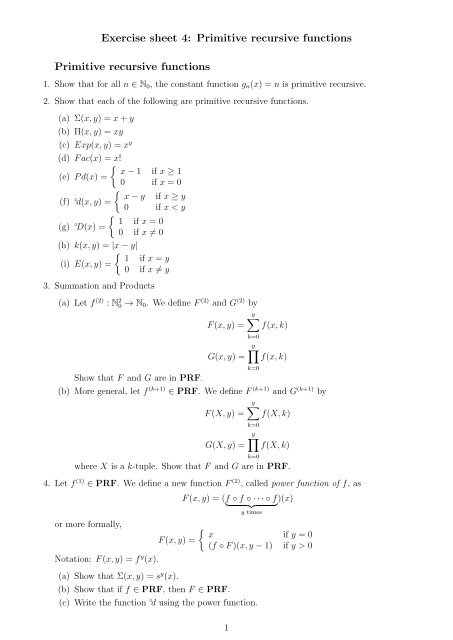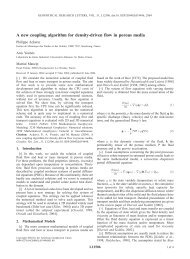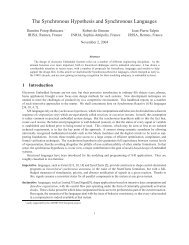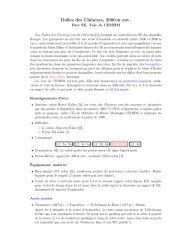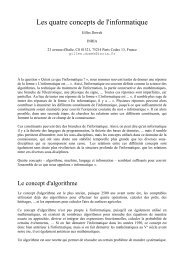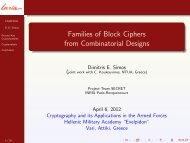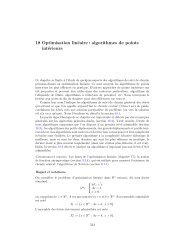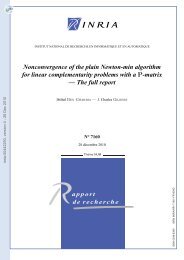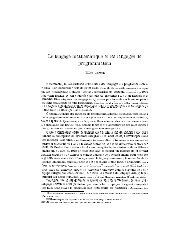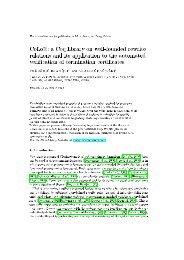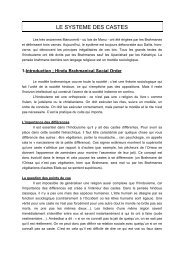Exercise sheet 4: Primitive recursive functions Primitive ... - Inria
Exercise sheet 4: Primitive recursive functions Primitive ... - Inria
Exercise sheet 4: Primitive recursive functions Primitive ... - Inria
Create successful ePaper yourself
Turn your PDF publications into a flip-book with our unique Google optimized e-Paper software.
<strong>Exercise</strong> <strong>sheet</strong> 4: <strong>Primitive</strong> <strong>recursive</strong> <strong>functions</strong><br />
<strong>Primitive</strong> <strong>recursive</strong> <strong>functions</strong><br />
1. Show that for all n ∈ N 0 , the constant function g n (x) = n is primitive <strong>recursive</strong>.<br />
2. Show that each of the following are primitive <strong>recursive</strong> <strong>functions</strong>.<br />
(a) Σ(x, y) = x + y<br />
(b) Π(x, y) = xy<br />
(c) Exp(x, y) = x y<br />
(d) F ac(x) = x!<br />
{ x − 1 if x ≥ 1<br />
(e) P d(x) =<br />
0 if x = 0<br />
{ x − y if x ≥ y<br />
(f) ◦ d(x, y) =<br />
0 if x < y<br />
{ 1 if x = 0<br />
(g) ◦ D(x) =<br />
0 if x ≠ 0<br />
(h) k(x, y) = |x − y|<br />
{ 1 if x = y<br />
(i) E(x, y) =<br />
0 if x ≠ y<br />
3. Summation and Products<br />
(a) Let f (2) : N 2 0 → N 0 . We define F (2) and G (2) by<br />
y∑<br />
F (x, y) = f(x, k)<br />
Show that F and G are in PRF.<br />
G(x, y) =<br />
k=0<br />
y∏<br />
f(x, k)<br />
(b) More general, let f (k+1) ∈ PRF. We define F (k+1) and G (k+1) by<br />
y∑<br />
F (X, y) = f(X, k)<br />
G(X, y) =<br />
k=0<br />
k=0<br />
y∏<br />
f(X, k)<br />
k=0<br />
where X is a k-tuple. Show that F and G are in PRF.<br />
4. Let f (1) ∈ PRF. We define a new function F (2) , called power function of f, as<br />
or more formally,<br />
Notation: F (x, y) = f y (x).<br />
F (x, y) =<br />
(a) Show that Σ(x, y) = s y (x).<br />
(b) Show that if f ∈ PRF, then F ∈ PRF.<br />
F (x, y) = (f ◦ f ◦ · · · ◦ f)(x)<br />
} {{ }<br />
y times<br />
{ x if y = 0<br />
(f ◦ F )(x, y − 1) if y > 0<br />
(c) Write the function ◦ d using the power function.<br />
1
<strong>Primitive</strong> <strong>recursive</strong> sets<br />
Reminder: Let k ∈ N. A subset A ⊆ N k 0 is said to be a primitive <strong>recursive</strong> set (A ∈ PRS) if<br />
its characteristic function χ A : N k 0 → N is primitive <strong>recursive</strong>.<br />
5. Show that every unitary subset of N 0 is in PRS.<br />
6. Show that if A, B ⊆ N 0 are in PRS, then A ∪ B, A ∩ B and N 0 \ A are in PRS.<br />
7. Show that every finite subset of N 0 is in PRS.<br />
8. Repeat the previous three exercises considering subsets of N k 0 with k ∈ N.<br />
9. Show that the set of even numbers is in PRS.<br />
10. Show that the set of numbers multiple of 3 is in PRS.<br />
Tip: Show that the function r 3 : N 0 → N 0 which takes a natural number and outputs the rest<br />
of its division by 3 is in PRF. Then write the characteristic function of the set of multiple of<br />
3 in terms of r 3 .<br />
<strong>Primitive</strong> <strong>recursive</strong> relations<br />
Reminder: A relation R ⊆ N 0 × N 0 is said to be a primitive <strong>recursive</strong> relation (R ∈ PRR) if<br />
it is in PRS.<br />
11. Show that =, ≠, ≤ and > are in PRR.<br />
12. Prove that if R, S ∈ PRR, then the following relations are also in PRR<br />
(a) xT y = xRy ∧ xSy<br />
(b) xUy = xRy ∨ xSy<br />
(c) x(¬R)y = ¬(xRy)<br />
13. Looking at the last exercises, is there any other way to prove =, >∈ PRR<br />
14. Let R ∈ N 0 × N 0 . We define ∧ R and ∨ R as follows.<br />
x( ∧ R)y = ∀k ∈ N 0 • 0 ≤ k ≤ y ⇒ xRk<br />
x( ∨ R)y = ∃k ∈ N 0 • 0 ≤ k ≤ y ∧ xRk<br />
Show that if R is in PRR, then ∧ R and ∨ R are also in PRR.<br />
Extra<br />
15. Show that the following function is primitive <strong>recursive</strong>.<br />
⎧<br />
⎨ x 2 if x is multiple of 3<br />
f(x) = x + 3 if x has a rest of 1 when dividing by 3<br />
⎩<br />
x! if x has a rest of 2 when dividing by 3<br />
16. Show that the divisibility relation between natural numbers is in PRR.<br />
Tip: Define the family of <strong>functions</strong> r a (1) for a = 1, 2, . . . such that r a<br />
(1) (n) outputs the rest of<br />
the division of n by a. Then write the characteristic function of the relation in terms of those<br />
<strong>functions</strong>.<br />
2


